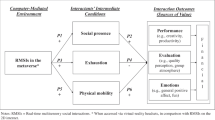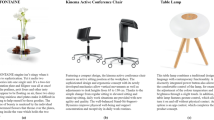Abstract
In this paper, we articulate the role of movement within a perceptual-motor view of tangible interaction. We argue that the history of human–product interaction design has exhibited an increasing neglect of the intrinsic importance of movement. On one hand, human–product interaction design has shown little appreciation in practice of the centrality of our bodily engagement in the world. This has resulted in technologies that continue to place demands on our cognitive abilities, and deny us the opportunity of building bodily skill. On the other hand, the potential for movement in products to be a meaningful component of our interaction with them has also been ignored. Both of these directions (design for bodily engagement and the expressiveness of product movements) are sketched out, paying particular respect for their potential to impact both interaction aesthetics and usability. We illustrate a number of these ideas with examples.









Similar content being viewed by others
References
Dunne A (1999) Hertzian tales: electronic products, aesthetic experience and critical design. Ph.D thesis. RCA CRD Research, London
Djajadiningrat JP, Gaver WW, Frens JW (2000) Interaction relabelling and extreme characters: methods for exploring aesthetic interactions. In: Proceedings of DIS’00, designing interactive systems. ACM, New York, pp 66–71
Hallnås L, Redström J (2002) From use to presence: on the expressions and aesthetics of everyday computational things. ACM transactions of computer–human interaction, vol. 9, no. 2, June 2002, pp 106–124
Gaver W, Beaver J, Benford S (2003) Ambiguity as a resource for design. In: Proceedings of ACM conference on human factors in computing systems, CHI 2003, April 5–10, 2003, Ft. Lauderdale, pp 233–240
Petersen MG, Iversen O, Krogh P, Ludvigsen M (2004) Aesthetic interaction—a pragmatist aesthetics of interactive systems. DIS2004, pp 269–276
Norman DA (2003) Emotional design: why we love (Or hate) everyday things. Basic books
Desmet PMA (2003) A multilayered model of product emotions. Des J 6(2):4–13
Locher P, Martindale C, Dorfman L, Leontiev D (2005) New directions in aesthetics, creativity, and the arts. Baywood, Amityville
Dunne A, Raby F (2001) Design noir: the secret life of electronic objects. Princeton Architectural Press, New York
Buur J, Jensen MV, Djajadiningrat JP (2004) Hands-only scenarios and video action walls—novel methods for tangible user interaction design. Proceedings DIS2004, pp 185–192
Maeda J (1999) Design by numbers. MIT, Cambridge
Kyffin S, Feijs L, Djajadiningrat T (2005) Exploring expression of form, action, and interaction. In: Proceedings of HOIT2005, York, pp 171–192
Winograd T, Flores CF (1987) Understanding computers and cognition: a new foundation for design. Addison-Wesley, Reading
Suchman LA (1987) Plans and situated actions: the problem of human–machine communication. Cambridge University Press, New York
Shusterman R (1992) Pragmatist aesthetics. Blackwell, Oxford
Clancey WJ (1997) Situated cognition: on human knowledge and computer representations. Cambridge University Press, Cambridge
Gibson JJ (1979) The ecological approach to visual perception. Houghton Mifflin, Boston
Coyne R, Snodgrass A (1993) Rescuing CAD from rationalism. Des Stud 14:100–123
Ingold T (2001) Beyond art and technology: the Anthropology of Skill. In: Schiffer HB (ed) anthropological perspectives on technology. University of New Mexico Press, Albuquerque, pp 17–33
Dreyfus HL, Dreyfus SE (1987) The mistaken psychological assumptions underlying the belief in expert systems. In: Costall A (ed) A still cognitive psychology in question, Harvester Press, Brighton, pp 17–31
Robertson T (2000) Building bridges: negotiating the gap between work practice and technology design. Int J Human Comput Stud 53:121–146
Dourish P (2001) Where the action is: the foundations of embodied interaction. MIT, Cambridge
Farnell B (1999) Moving bodies, acting selves. Annu Rev Anthropol 28:341–373
Overbeeke CJ, Djajadiningrat JP, Hummels CCM, Wensveen SAG (2002) Beauty in usability: forget about ease of use! In: Green WS, Jordan PW (eds) Pleasure with products: beyond usability. Taylor & Francis, pp 9–18
Djajadiningrat JP, Wensveen SAG, Frens JW, Overbeeke CJ (2004) Tangible products: redressing the balance between appearance and action. Spec Issue Tangible Interaction J Pers Ubiquitous Comput 8:294–309
Øritslund TA, Buur J (2000) Taking the best from a company history—designing with interaction styles. In: Proceedings of the conference on designing interactive systems (DIS2000), New York City, August 2000, pp 27–38
Hummels CCM, Smets GJF, Overbeeke CJ (1998) An intuitive two-handed gestural interface for computer supported product design. In: Proceedings of the Gesture Workshop ‘97. Springer, Berlin Heidelberg, New York
Cassell J (1998) A framework for gesture generation and interpretation. In: Cipolla R, Pentland A (eds) Computer vision in human–machine interaction. Cambridge University Press, New York, pp 191–215
Norman DA (1990) The design of everyday things. Doubleday Currency, New York
Jensen MV, Buur J, Djajadiningrat JP (2005) Designing the user actions in tangible interaction. Accepted for critical computing: between sense and sensibility, Aarhus
Sudnow D (2001) Ways of the hand. A rewritten account. MIT, Cambridge
McBride JA (2002) Between dance and language. In: McNeill D (ed) Hand and mind, University of Chicago Press, Chicago
Klooster S, Overbeeke CJ (2004) Design education moves, movement as a tool for design education, to develop sensitivity and empathy. In: Proceedings of the 2nd international engineering and product design education conference, Delft, September 2004 (in press)
Buxton W (1986) There’s more to interaction than meets the eye: some issues in manual input. In: Norman DA, Draper SW (eds) User centered system design: new perspectives on human–computer interaction. Lawrence Erlbaum Associates, Hillsdale, pp 319–337
Malone TW, Lepper MR (1987) Making learning fun: a taxonomy of intrinsic motivations for learning. In: Snow RE, Farr MJ (eds) Aptitude, learning, and instruction: cognitive and affective process analysis, vol 3, Lawrence Erlbaum, Hillsdale, pp 223–253
Draper SW (1999) Analysing fun as a candidate software requirement. Pers Technol 3:117–122
Buxton W, Myers B (1986) A study in two-handed input. In: Proceedings of the CHI’86 conference on human factors in computing systems, Boston, 13–17 April 1986, pp 321–326
Guiard Y (1987) Asymmetric division of labor in human skilled bimanual action: the kinematic chain as a model. J Mot Behav 19(4):486–517
Stienstra M (2003) Is every kid having fun? A gender approach to interactive toy design. Twente University Press, Enschede, 2003
Hoonhout HCM, Stienstra M (2003) Exploring enjoyability: which factors in a consumer device make the user smile. In: Waard DD, Brookhuis K, Sommer S, Verwey W (eds) Human factors and ergonomics society Europe chapter annual meeting, human factors in the age of virtual reality, on the occasion of the in Dortmund, Germany, October 2002. Shaker Publishing, Dortmund, pp 341–355
Frens JW (2005) A rich user interface for a digital camera. Pers ubiquitous comput, ISSN: 1617–4909 (Paper) 1617–4917 (Online) DOI: 10.1007/s00779-05-0013-z
Houde S, Salomon G (1993) Working towards rich and flexible representations. In: Adjunct proceedings of the joint conference of ACM SIGCHI and INTERACT (INTERCHI’93), Amsterdam, April 1993, pp 9–10
Heider FRF, Simmel M (1944) An experimental study of apparent behaviour. Am J Psychol 57:243–249
Picard RW (1997) Affective computing. MIT, Cambridge
Bartneck C (2003) Interacting with an embodied emotional character. DPPI, pp 55–60
DiSalvo CF, Gemperle F, Forlizzi J, Kiesler S (2002) All robots are not created equal: the design and perception of humanoid robot heads. DIS2002, pp 321–326
Bloom P, Veres C (1999) The perceived intentionality of groups. Cognition 71:B1–B9
Berry DS, Misovich SJ, Kean KJ, Baron RM (1992) Effects of disruption of structure and motion on perceptions of social causality. Pers Soc Psychol Bull 18:237–244
Russell JA (1980) A circumplex model of affect. J Pers Soc Psychol 39:1161–1178
Engström Y (1987) Learning by expanding. Orienta-Konsultit, Helsinki
Wensveen SAG, Djajadiningrat JP, Overbeeke CJ (2004) Interaction frogger: a design framework to couple action and function through feedback and feedforward. DIS2004, pp 177–184
Michotte A (1963) The perception of causality. Basic Books, New York
Svanaes D, Verplank W (2000) In search of metaphors for tangible user interfaces. In: Conference on designing augmented reality environments, 2000
Reeves B, Nass C (1996) The media equation: how people treat computers, television, and new media like real people and places. CSLI Publications, Cambridge University Press, Stanford
Scholl BJ, Tremoulet PD (2000) Perceptual causality and animacy. Trends Cogn Sci 4(8):299–309
Acknowledgments
We gratefully acknowledge the following people: Jacob Buur of the Mads Clausen Institute for his intellectual guidance towards a ‘skills’ view on tangible interaction; Loe Feijs of the Designed Intelligence Group and Steven Kyffin of Philips Design for their seminal thinking on 4D form: Loe for enthusiastically providing Semotion students with crash courses on semiotic theory and microprocessor controlled servos, and Steven for his highly motivating briefing and coaching of students on design expressiveness; Ton van de Graft for technology support; Peter Peters for co-organizing the Stacked Actions assignment; Loe Feijs, Geert van de Boomen and Peter Peters for their help on the electronics of the thermostat prototype; Meindert Janszen and Jos van de Laat for the physical prototyping of the thermostat; and of course, our students on the IT-Product Design course of the University of Southern Denmark and the Industrial Design course of TU Eindhoven for their hard work on the examples shown and their willingness to suspend their disbelief.
Author information
Authors and Affiliations
Corresponding author
Rights and permissions
About this article
Cite this article
Djajadiningrat, T., Matthews, B. & Stienstra, M. Easy doesn’t do it: skill and expression in tangible aesthetics. Pers Ubiquit Comput 11, 657–676 (2007). https://doi.org/10.1007/s00779-006-0137-9
Received:
Accepted:
Published:
Issue Date:
DOI: https://doi.org/10.1007/s00779-006-0137-9




